EccentricFantasy
The mind is a fearsome thing, don't tread on it.
Keep in mind this will be an ever growing thing. I will add to it, but you will as well. If you want to make a town for your character to come from or live in, send me the lore set up in PM so I can look over it. If it looks good, we will add it here. Keep in mind that it's bare bones to allow you all room to expand and make a story you love!
The Quianmon Islands

Prosperous and filled with magic, the Quianmon Lands surround a distinctive rock formation that protects the lands most guarded secret. Located on an island just off the cost of Nurikan, the people of Quianmon revere the water which has flowed through the very fabric of their culture since the age of the gods.
The Empire of Nurikan
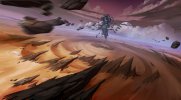
Barren and hot, the arid and sparse Lands of Nurikan are home to a self-sufficient, improvisational culture that has learned to thrive in a landscape of nearly constant drought. Living in loosely-connected settlements, the people of Nurikan value their independence and self-reliance. Home to the most secrets among the nations.
The Republic of Issathra

This vibrant, bustling market nation once attracted traders from all the Lands of the continent thanks to its central location along the geographically. Expanding wetlands and rivers have drawn its merchants from far off lands towards the shops all along an ever-expanding labyrinth of docks and boats.
The Empire of Henuo
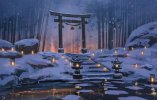
Isolated and remote, the Lands of Henuo are marked by spectacular, snowy mountains and towering black bamboo. Home to the fiercest warriors in all the continent, its people are proud and reclusive. Despite being the strongest nation in a combat sense, they possess less natural resources than even Nurikan.
The Federation of Sulwor
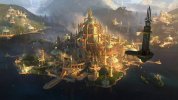
Opulent, regimented and strong, Sulwor is positioned at the head of the political and economic practices on the continent and protected by a man-made canal that seperates them from the world. Its people work hard to safeguard their way of life, the secrets and corruption within.
Kakuti'kau
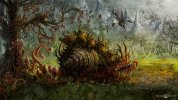
Kakuti'kau is a junkyard nation inhabited by outcasts. People who live there do not exist in any official records, and the existence of the nation itself is known to very few people. Not much is known about the nation or people as much of its information is shrouded in mystery. It is rumored to be at least 1500 years old, and to have been founded as an internment camp set up by the dictators of old. Since then, it has been a dumping ground for other nations. The country is said to be the most diverse place on the planet, and its population is estimated at eight to ten million. A festering wasteland of disease, it's people thought to be able to survive anything.
The Kingdom of Oss'Kell
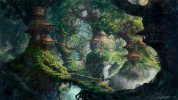
Oss'Kell is a slice of paradise connected to the new world by a massive canyon that completely cuts them off from normal society. There are two sides to it - a vast land that resembles Africa with its flora and fauna, housing small villages of humans and other races of people. The other side is larger, possibly even rivaling large empires kingdoms, such as Sulwor or even the combined population of the other countries.

The Quianmon Islands

Prosperous and filled with magic, the Quianmon Lands surround a distinctive rock formation that protects the lands most guarded secret. Located on an island just off the cost of Nurikan, the people of Quianmon revere the water which has flowed through the very fabric of their culture since the age of the gods.
The Empire of Nurikan

Barren and hot, the arid and sparse Lands of Nurikan are home to a self-sufficient, improvisational culture that has learned to thrive in a landscape of nearly constant drought. Living in loosely-connected settlements, the people of Nurikan value their independence and self-reliance. Home to the most secrets among the nations.
The Republic of Issathra

This vibrant, bustling market nation once attracted traders from all the Lands of the continent thanks to its central location along the geographically. Expanding wetlands and rivers have drawn its merchants from far off lands towards the shops all along an ever-expanding labyrinth of docks and boats.
The Empire of Henuo

Isolated and remote, the Lands of Henuo are marked by spectacular, snowy mountains and towering black bamboo. Home to the fiercest warriors in all the continent, its people are proud and reclusive. Despite being the strongest nation in a combat sense, they possess less natural resources than even Nurikan.
The Federation of Sulwor

Opulent, regimented and strong, Sulwor is positioned at the head of the political and economic practices on the continent and protected by a man-made canal that seperates them from the world. Its people work hard to safeguard their way of life, the secrets and corruption within.
Kakuti'kau

Kakuti'kau is a junkyard nation inhabited by outcasts. People who live there do not exist in any official records, and the existence of the nation itself is known to very few people. Not much is known about the nation or people as much of its information is shrouded in mystery. It is rumored to be at least 1500 years old, and to have been founded as an internment camp set up by the dictators of old. Since then, it has been a dumping ground for other nations. The country is said to be the most diverse place on the planet, and its population is estimated at eight to ten million. A festering wasteland of disease, it's people thought to be able to survive anything.
The Kingdom of Oss'Kell

Oss'Kell is a slice of paradise connected to the new world by a massive canyon that completely cuts them off from normal society. There are two sides to it - a vast land that resembles Africa with its flora and fauna, housing small villages of humans and other races of people. The other side is larger, possibly even rivaling large empires kingdoms, such as Sulwor or even the combined population of the other countries.

